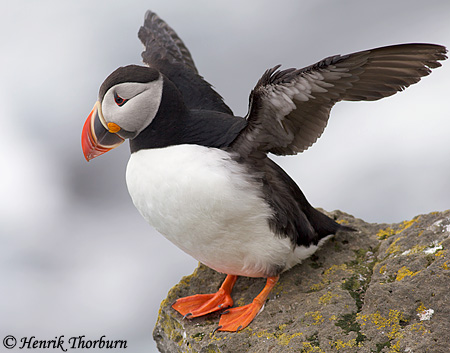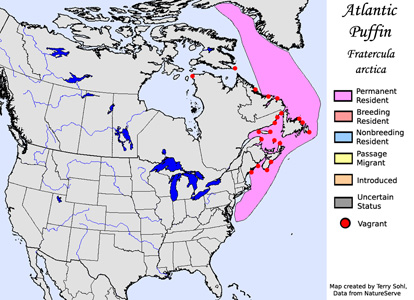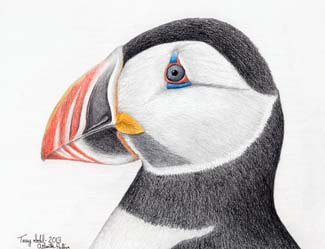| Length: 12.5 inches | Wingspan: 21 inches | Seasonality: Non-resident in South Dakota |
| ID Keys: Large multi-colored bill, fleshy protuberance above eye. Distinctive in range, especially in breeding season. | ||
 Atlantic
Puffins are one of the most well-known and charismatic birds for many, yet
relatively few people have the opportunity to see one in the wild in North
America. They breed on offshore rocky islands, and are typically only seen
in North America by those boating offshore. The species also breeds on the
European side of the Atlantic, and birds tagged on the two continents have been
found to have traveled across the Atlantic to the other continent, indicating
long-term migration and some intermingling of American and European populations.
The birds are very similar in appearance to the
Horned Puffin, a bird of the north Pacific. Atlantic Puffins are the
smallest of the three puffin species (the third species being the
Tufted Puffin).
Atlantic
Puffins are one of the most well-known and charismatic birds for many, yet
relatively few people have the opportunity to see one in the wild in North
America. They breed on offshore rocky islands, and are typically only seen
in North America by those boating offshore. The species also breeds on the
European side of the Atlantic, and birds tagged on the two continents have been
found to have traveled across the Atlantic to the other continent, indicating
long-term migration and some intermingling of American and European populations.
The birds are very similar in appearance to the
Horned Puffin, a bird of the north Pacific. Atlantic Puffins are the
smallest of the three puffin species (the third species being the
Tufted Puffin).
Habitat: Breeds on offshore islands in North America, with suitable islands having either rocky crevices or soil amenable to burrows for nesting. They prefer the cold waters of the Atlantic, and outside of the breeding season, may be found far out to sea.
Diet: Fish makes up a majority of the diet, with capelin, herring, and sand lance particularly preferred. Most food fed to the young is also fish. Adults will also consume crustaceans such as shrimp and copepods, as well as mollusks and marine worms.
Behavior: Food is acquired by swimming underwater and capturing fish and other prey with their beaks. Atlantic Puffins are capable of diving to nearly 200 feet, using their wings to "fly" through the water in search of prey.
Nesting: Atlantic Puffins either nest in burrows dug by the birds themselves, or in rocky crevices. Nesting burrows may be 7 feet deep or more.
Interactive eBird Map: Click to access an interactive eBird map of Atlantic Puffin sightings
Song: When in the open ocean and outside of the
breeding season, Atlantic Puffins are generally silent. On breeding
colonies, a harsh groaning is often heard.
Migration: After the breeding season, most birds
disperse far out to sea. They can be found from the edge of the pack ice
in the north, and have wandered as far south as off the coast of Florida in
winter.
Similar Species:
Horned Puffin,
Tufted
Puffin
Conservation Status: Populations declined drastically in the 1800s as both
adult birds and eggs were taken. Declines continue in the southern
part of the North American range, as well as the southern part of the European
range. Disturbance and introduction of predators on nesting colony islands
are the primary reasons for the decline.
Further Information: 1)
Audubon.org - Atlantic Puffin
3)
Audubon Guide - Atlantic Puffin
Photo Information: June 24th, 2010 - Iceland - Henrik
Thorburn
Additional Photos: Click on the image chips or
text links below for additional, higher-resolution Tufted Puffin photos.
Conservation Status: Populations declined drastically in the 1800s as both
adult birds and eggs were taken. Declines continue in the southern
part of the North American range, as well as the southern part of the European
range. Disturbance and introduction of predators on nesting colony islands
are the primary reasons for the decline.
Further Information: 1)
Audubon.org - Atlantic Puffin
3)
Audubon Guide - Atlantic Puffin
Photo Information: June 24th, 2010 - Iceland - Henrik
Thorburn
Additional Photos: Click on the image chips or
text links below for additional, higher-resolution Tufted Puffin photos.
3) Audubon Guide - Atlantic Puffin
Photo Information: June 24th, 2010 - Iceland - Henrik Thorburn
Additional Photos: Click on the image chips or text links below for additional, higher-resolution Tufted Puffin photos.
| Click on the map below for a higher resolution view |
 |
| South Dakota Status: Non-resident in South Dakota |
Additional Atlantic Puffin Images
Click for a higher-resolution version of these images

